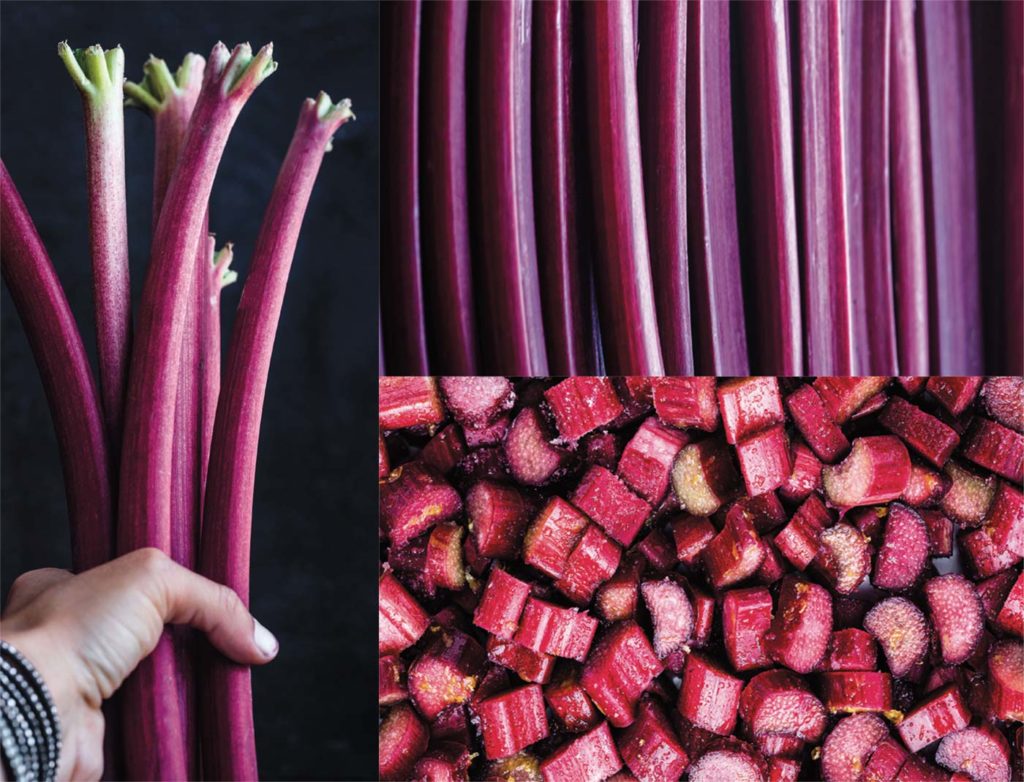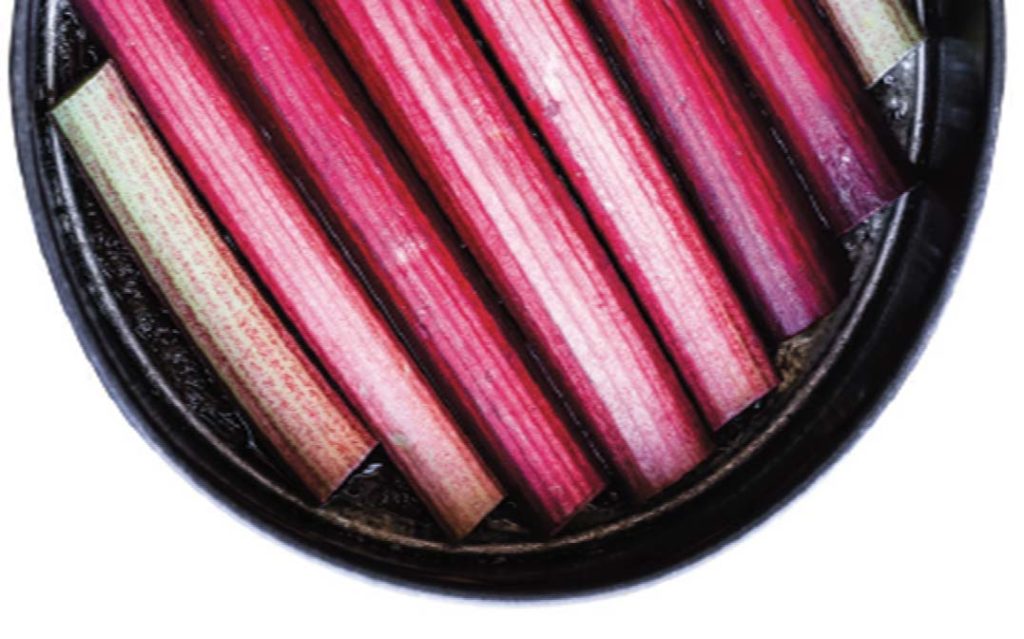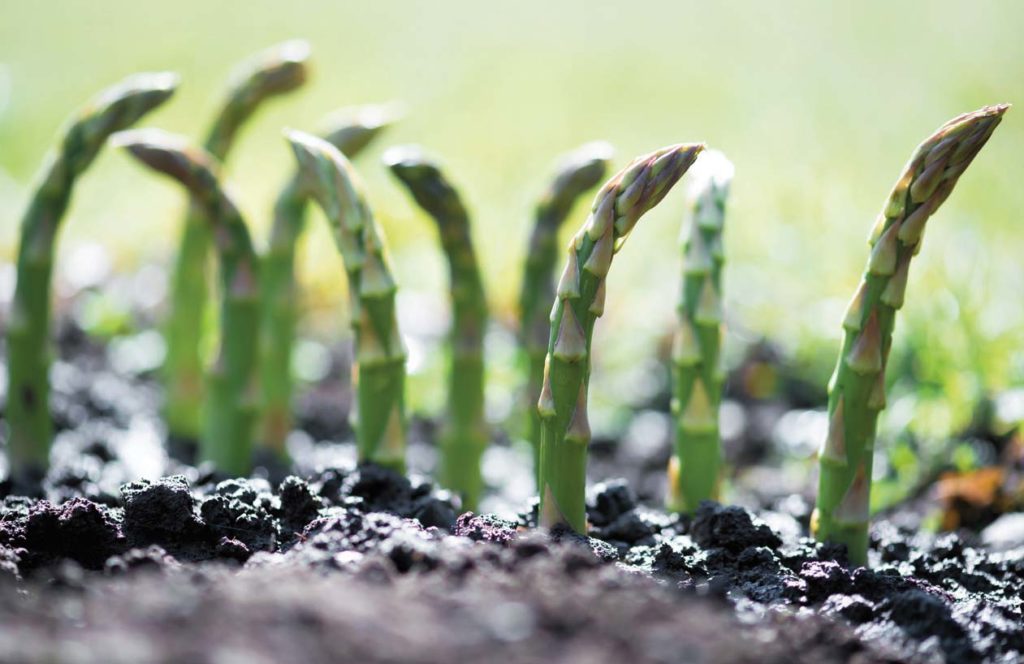PHOTOGRAPHY BY DANIELA GERSON

Add some springtime sizzle to jams, pies and savory dishes
Once spring has sprung and strawberries are in season, farmers’ market customers start asking for rhubarb—an elusive, shortseason crop. Those who covet the bright red stalks know their tart flavor pairs well with the sweetness of seasonal fruits, and the color rhubarb adds to jam and compotes is unsurpassed.
But once they’ve made their pies and jams, customers tend not to buy it again. As a farmer who has grown rhubarb now and again over the past 20 years, it was never the niche crop or big seller I had hoped it might be. Sitting down to write this article had me going down the rabbit hole discovering and brainstorming alternative uses for this gorgeous spring stalk, and pondering how it could be used in savory dishes. After all, it is like a tart version of celery. Could rhubarb be considered for much more than pastries? Is its potential being overlooked, when it could be the next big thing?
Kerri Williams, field merchandiser at Veritable Vegetable in San Francisco, says people start asking about rhubarb in February and get excited once it becomes available from late March to mid-May; however, sales typically fizzle after a week or two. Farmers who grow it are always trying to sell more rhubarb than people are willing to buy. In the Pacific Northwest, Washington tends to move a lot more rhubarb than other states because it is served there in fresh juices and strawberry rhubarb lemonade.
Much of the commercially grown, organic rhubarb is farmed in greenhouses in Oregon’s Willamette Valley. Rhubarb prefers cooler weather, however growing in the warmth of the greenhouse during the winter months brings out the gorgeous red in the stalks and makes them sweeter.
Locally, the only farm I am aware of that grows rhubarb is Sea to Sky Farm in Bonny Doon. Chris Laughlin grows a quarter-acre of rhubarb and sells it for about six weeks in the springtime at all the Santa Cruz Community Farmers’ Markets. Her customers say they use it to make strawberry rhubarb pie or jam. The exception is Jennifer Ashby of Ashby Confections in Scotts Valley, who buys rhubarb from Sea to Sky to make her fabulous farm-to-candy strawberry rhubarb sour strips and pâte de fruits.
MEDICINAL ROOTS
Rhubarb is a large plant with big leaves in the Polygonaceae family, which also includes many types of the most prolific weeds including knotweeds. Edible buckwheat and sorrel are part of the same family. However, before rhubarb stalks became a culinary delight in the 1700s, its roots were prized as a medicinal purgative due to the tannins and fiber they contain. It grew abundantly wild all over the mountains west of what is now Beijing and was traded in China and Mongolia. Explorer Marco Polo noted that the yellow root was purchased and distributed all over the world via Silk Road caravan routes east to Turkey and Russia. By the 1500s the root was worth much more than saffron or cinnamon because it came from so far away.
By the 1600s Russia sought to monopolize the rhubarb trade with Europe, and if other merchants tried to sell the root or the seeds, they would be punished by death. Later in the United States rhubarb became a new food source. It wasn’t well known yet that the leaves are toxic due to high levels of oxalic acid—which can cause kidney stones and other organ failures.
President Thomas Jefferson enjoyed dining on rhubarb leaves so much that he planted them at his home and in his planting notes touted them as just as delicious as spinach. Jefferson died at age 83 from a kidney infection and other issues. One can wonder if rhubarb was the cause of his demise. Nowadays only the bright red stalks are sold in grocery stores, so consumers will not unknowingly ingest the acidic leaves.
In many countries pieces of rhubarb stalk are washed, rolled in sugar and given to children as crunchy sweet-tart treats. Rich in fiber, vitamins and minerals and only containing two ingredients, these seem like a much better alternative to the sweets kids eat today.

GROWING RHUBARB
Technically a vegetable, rhubarb can easily be grown on the Central Coast either from seed or roots. If grown from seed, it will take three or more years before it can be harvested, so if you don’t want to wait that long, purchase and plant crown divisions instead. Rhubarb crowns will produce stalks the first year, but should be harvested only in the second season to give the plants a chance to establish. Make sure you have a large space for each plant, as it needs a 3-foot-square area to grow well. Two of the desirable varieties that produce the brightest red stalks and the best flavor are cherry red and crimson red. One or two plants will yield plenty for one family to make many desserts with.
Gopher baskets are a good idea, not because they eat the roots but the varmints tend to move the plants around and move them out of the drip irrigation line. Plant rhubarb in full sun unless you are in a hotter zone, then plant them where they can get partial shade at the warmest part of the day.
I have two growing halfway under my fruit trees and they do very well there because we are south facing and the sun tends to bake during the summer months. But because the trees are deciduous they allow for all day sun in the winter and early spring, which benefits the rhubarb. Rhubarb needs a lot of water, but only thrives in well-drained soils. Fertilize once a year in the late winter, either with composted manure or a nitrogen-rich organic pellet fertilizer, to promote growth of leaves and stalks.
UNCONVENTIONAL USES
Rhubarb stalks are typically only available in spring for a short time. If you find some, be sure to load up so you can experiment with them. If you find lighter pink or even green rhubarb stalks, don’t worry; they still have the same culinary components that the red varieties have, they just won’t provide the magnificent color. When buying, look for firm stalks that have ends that don’t appeared dried out, as this means the water has been lost in the stalk and it isn’t as fresh. While large stalks are the norm at grocery stores, thinner stalks are actually more tender and sweeter, if you can find them.
Rhubarb shouldn’t be overlooked as it is high in vitamins C, A and K and fiber, which help to lower cholesterol. It also has antioxidants that have many anti-inflammatory benefits to protect your heart.
There are many different things you can make with rhubarb including savory dishes. The tartness and slight bitterness of rhubarb adds an extra dimension to sweet or salty dishes and helps create a balanced flavor. Rhubarb also freezes well, so think about chopping and freezing a bunch to try various preparations with throughout the year. Here are some outside-the-box ideas for using rhubarb:
Make syrup that can be used in various preparations. Cook rhubarb down with some sugar, maple syrup or honey and water. Use a 1:1 ratio of water to sugar. Enjoy on pancakes, waffles or French toast. Mix the rhubarb syrup with some vanilla, cardamom and a splash of apple cider vinegar to make a shrub that can be mixed with bubbly water for a refreshing drink. Add gin or vodka if you desire. Or use the syrup as a base for a homemade barbecue sauce.
Make a natural colored sweet and sour sauce by adding the syrup to pineapple juice, rice vinegar and soy sauce. Use with fresh spring rolls, egg rolls or for sweet and sour chicken or pork. Try mixing the saturated rhubarb left over after making syrup with chili oil and add to a stir fry.
Make rhubarb chutney and eat it with savory meats and vegetables inside pita bread. Make a crunchy fruit salsa with rhubarb, mango, strawberries, cilantro, serrano peppers and lime juice.
Juice rhubarb with green apples, citrus fruits and ginger. Include in smoothies with yogurt and fruit like pineapples and strawberries.
Pickle it by combining with ½ cup sugar to 1 cup of water and 1 teaspoon of salt. Let mixture sit in refrigerator for 2 days before eating. Chop raw or pickled, or cook until soft in a little water and honey. Add to a green or grain salad.
Candy it. Start with a simple rhubarb syrup and dehydrate or cook down on low temperature until pliable to make fruit leather.

Rhubarb Upside Down Cake
Celebrate spring’s rhubarb bounty with this spiced yogurt upside down cake.

LOCAL FOODS IN SEASON
MARCH, APRIL AND MAY
FRUITS
Apricots* • Avocados • Blackberries* • Cactus Pears* • Grapefruit** • Kumquats** • Lemons • Limes** • Mandarins** • Oranges • Pomelos** • Rhubarb** • Strawberries
VEGETABLES
Artichokes • Arugula • Asparagus • Beets • Bok Choy • Broccoli• Broccoli Raab • Brussels Sprouts • Burdock • Cabbage • Cardoons • Carrots • Cauliflower • Celeriac* • Celery* • Chard • Chicory • Collards • Cress • Dandelion • Endive • Fava Beans and Greens • Fennel • Garlic • Horseradish • Kale • Kohlrabi • Leeks • Mushrooms • Mustard Greens • Nettles • Onions • Orach • Parsnips • Peas** • Pea Shoots • Potatoes • Radishes • Rutabagas** • Shallots • Spinach • Sprouts • Squash • Sunchokes • Turnips
SEAFOOD
Abalone • Crab, Dungeness • Grenadier, Pacific • Halibut, California* • Lingcod, Pacific • Rock Cod, aka Snapper or Rockfish • Sablefish, aka Black Cod • Salmon, King • Sanddabs, Pacific • Seabass, White • Sole (Dover and Petrale) • Spot Prawns • Squid
- May only ** March and April only ***April and May only
All fish listed are rated “Best Choice” or “Good Alternative” by the Monterey Bay Aquarium’s Seafood Watch program.
About the author
Jamie Collins is the owner of Serendipity Farms and has been growing organic row crops at the mouth of Carmel Valley since 2001. She distributes her produce through a CSA, u-picks and farmers’ markets.
- Jamie Collinshttps://www.ediblemontereybay.com/author/jcollins/
- Jamie Collinshttps://www.ediblemontereybay.com/author/jcollins/
- Jamie Collinshttps://www.ediblemontereybay.com/author/jcollins/
- Jamie Collinshttps://www.ediblemontereybay.com/author/jcollins/



